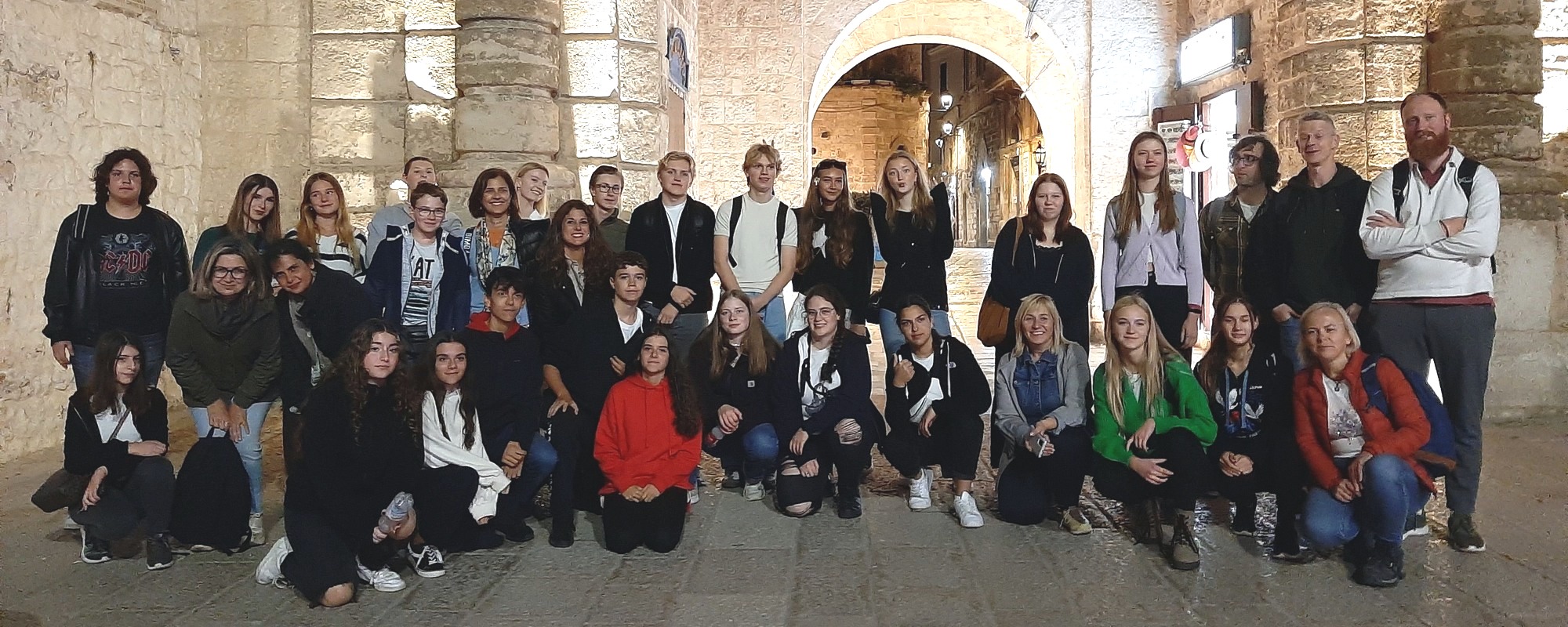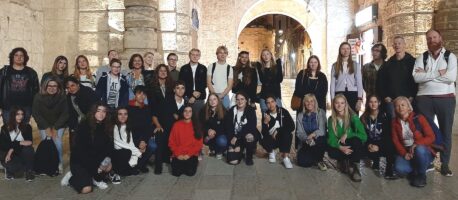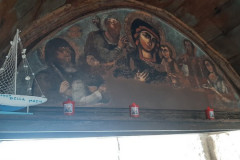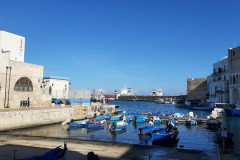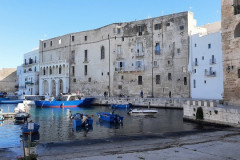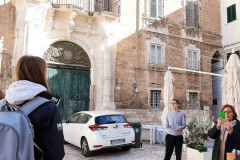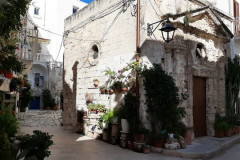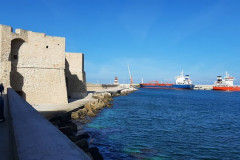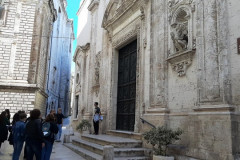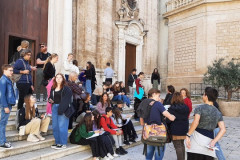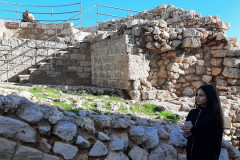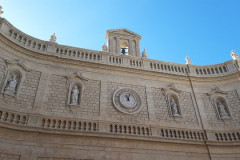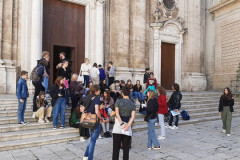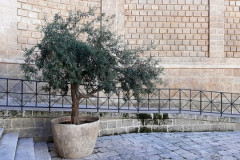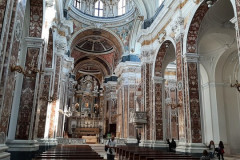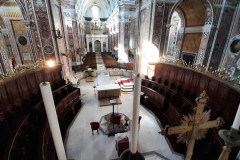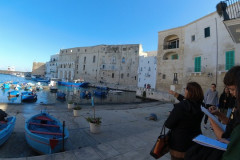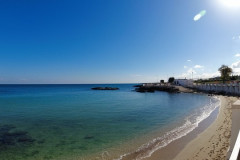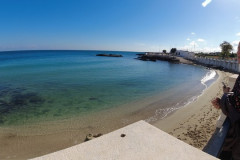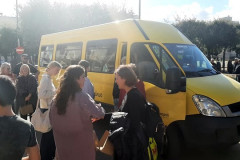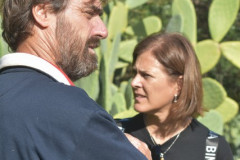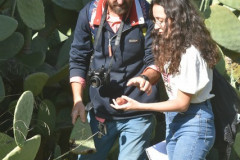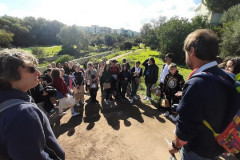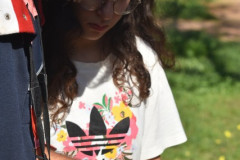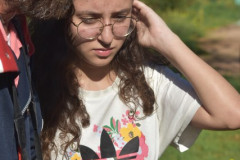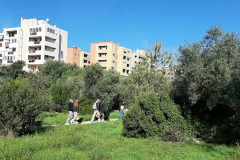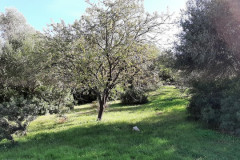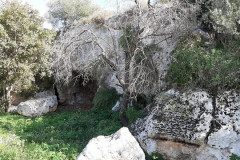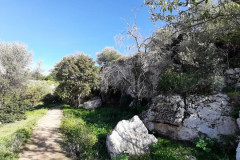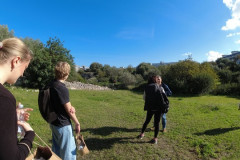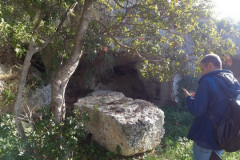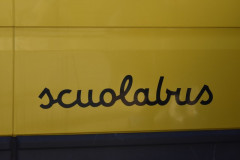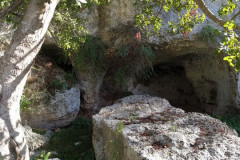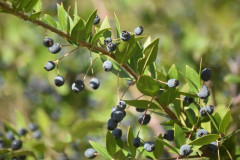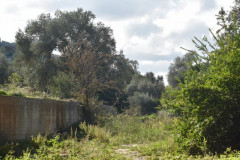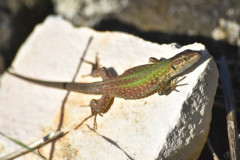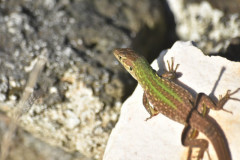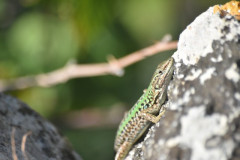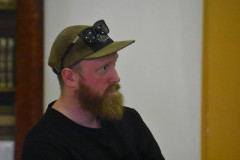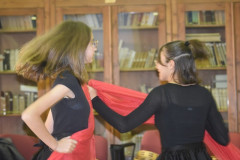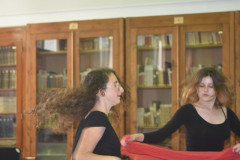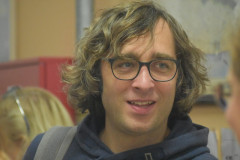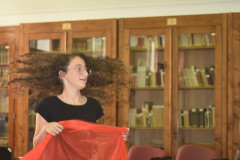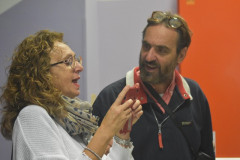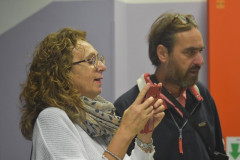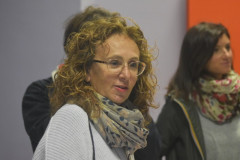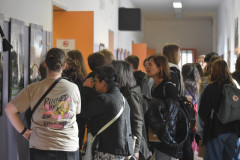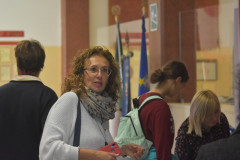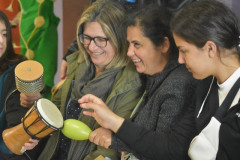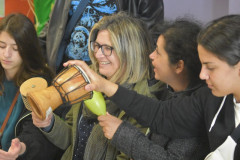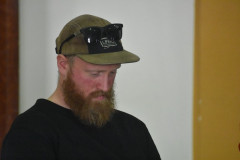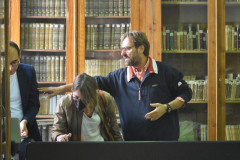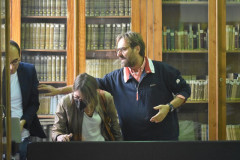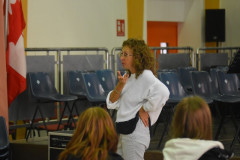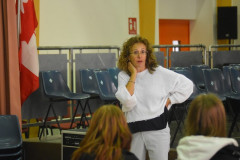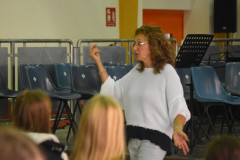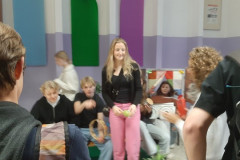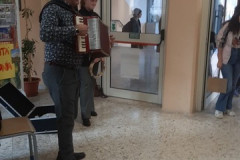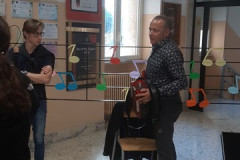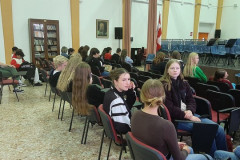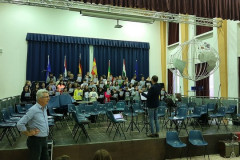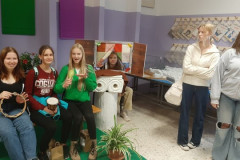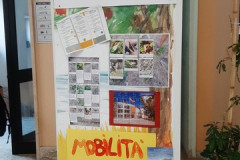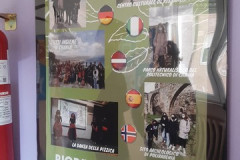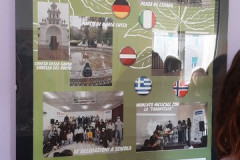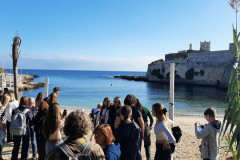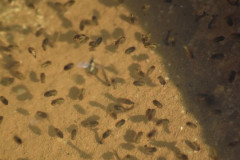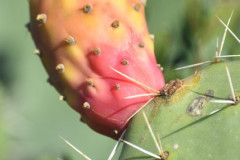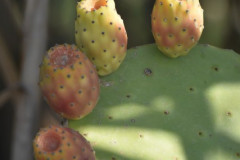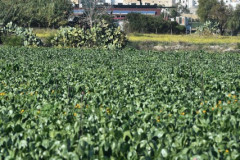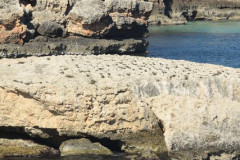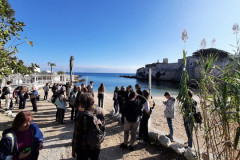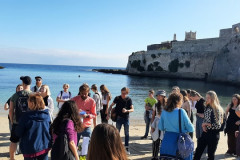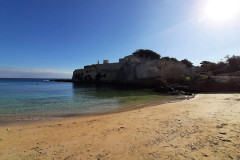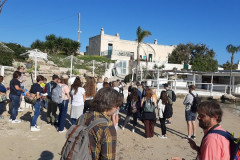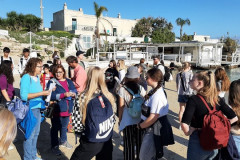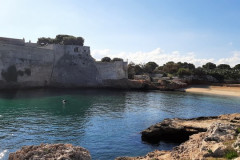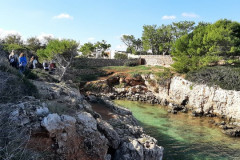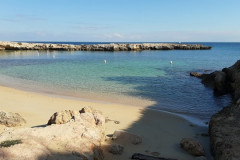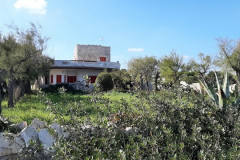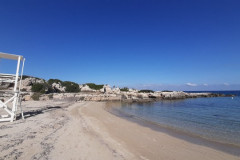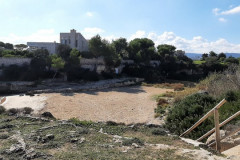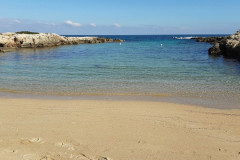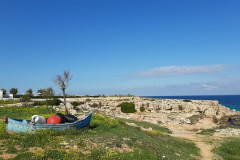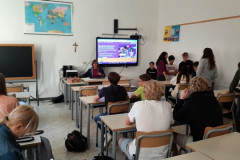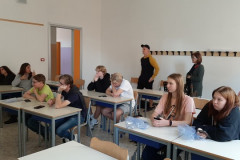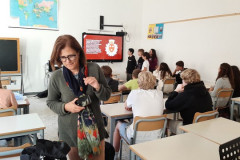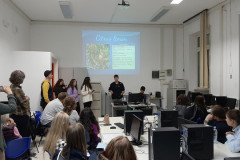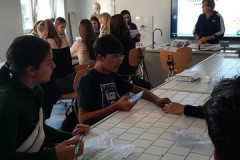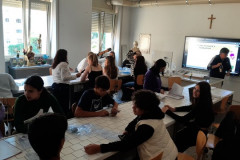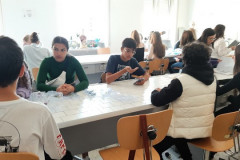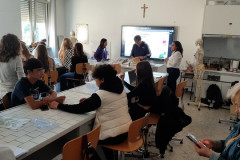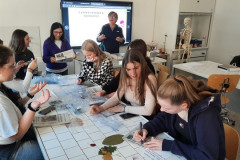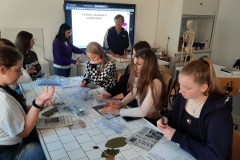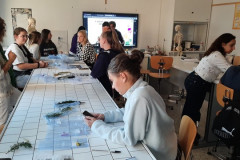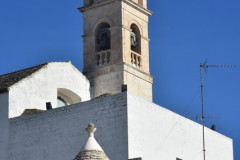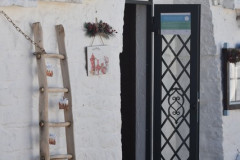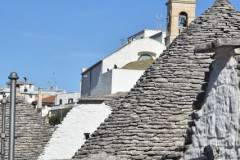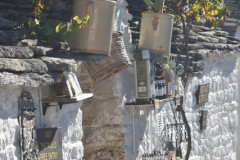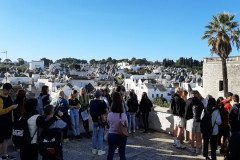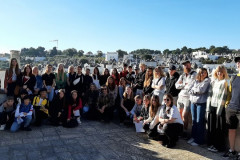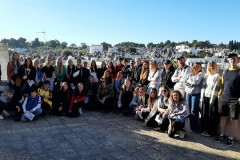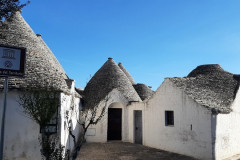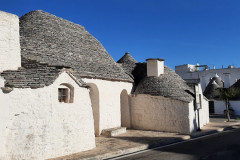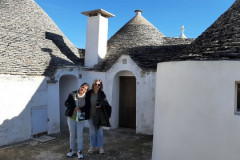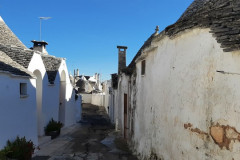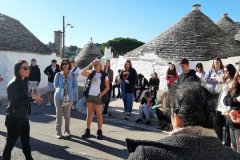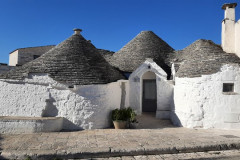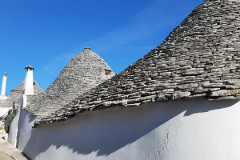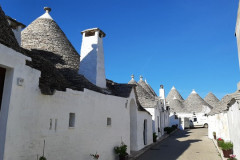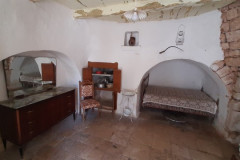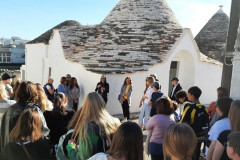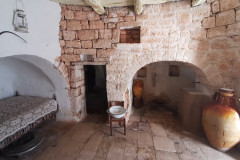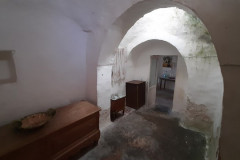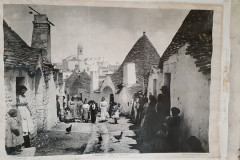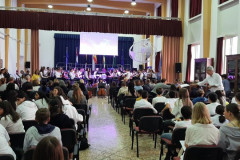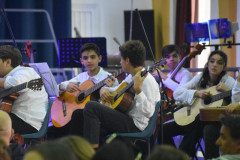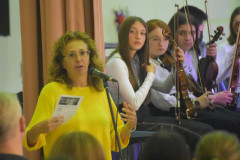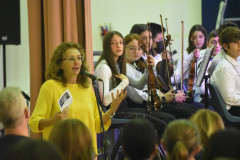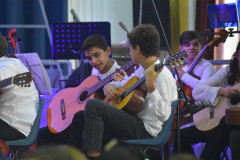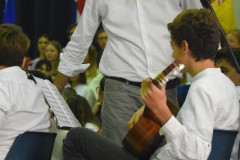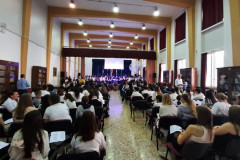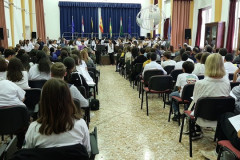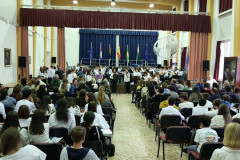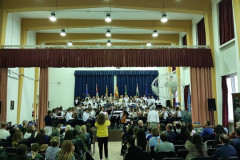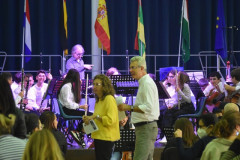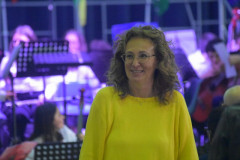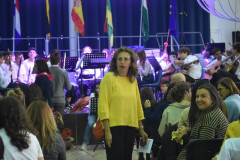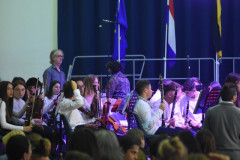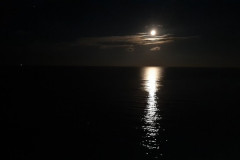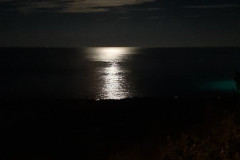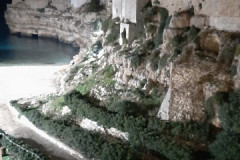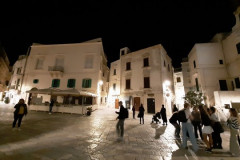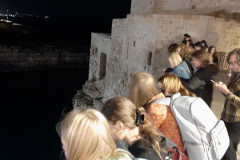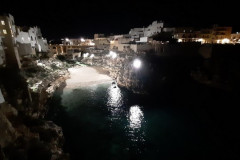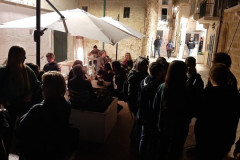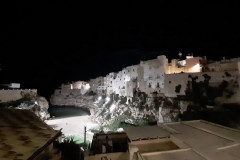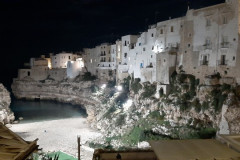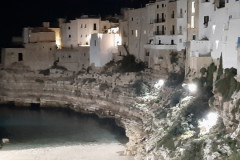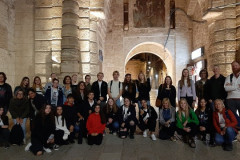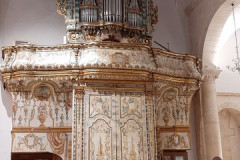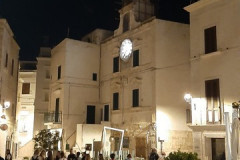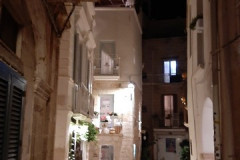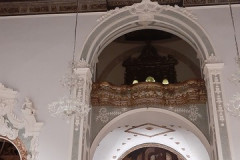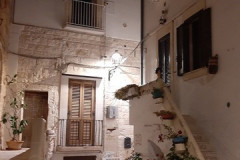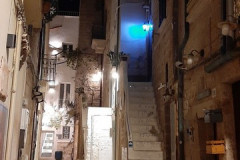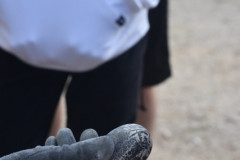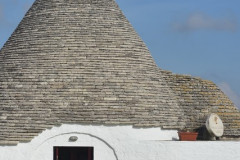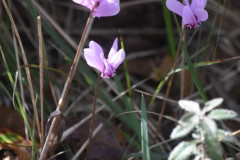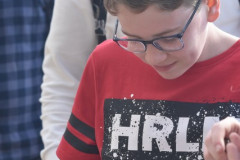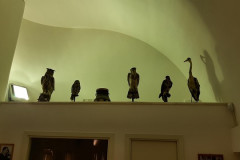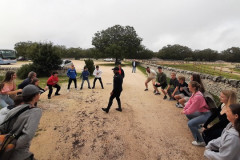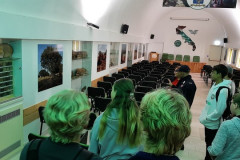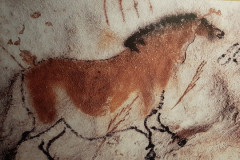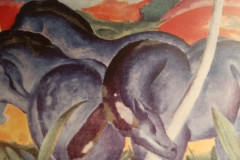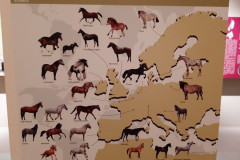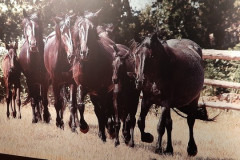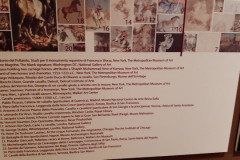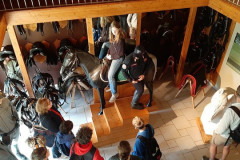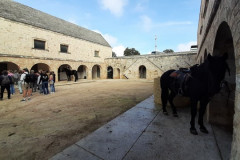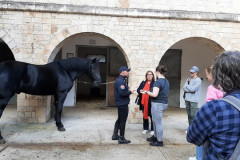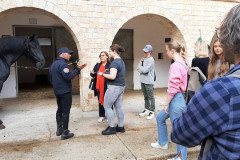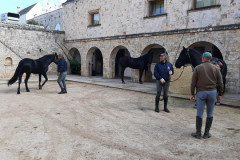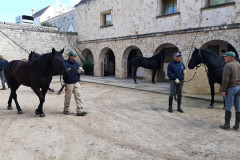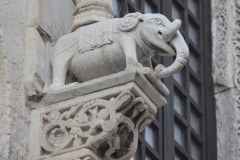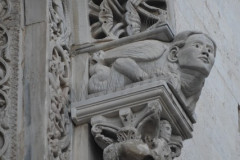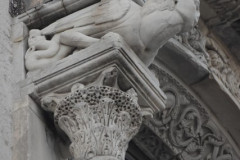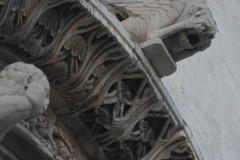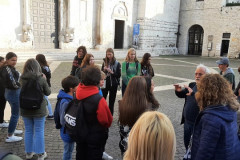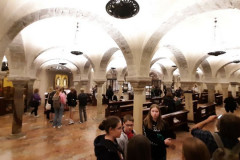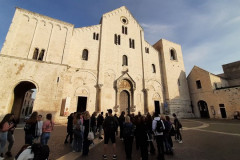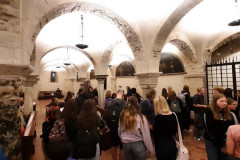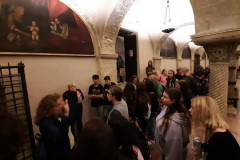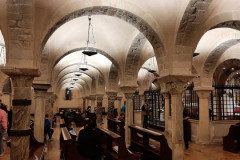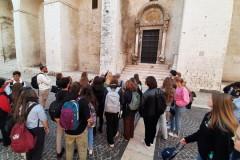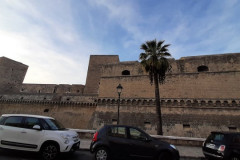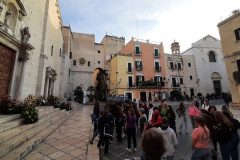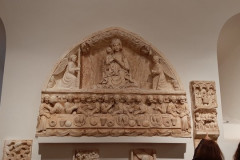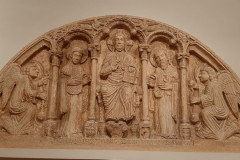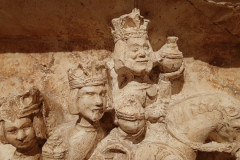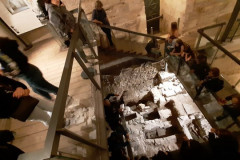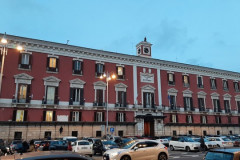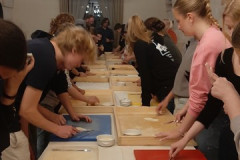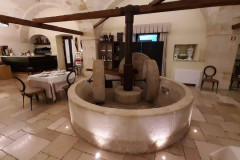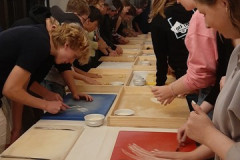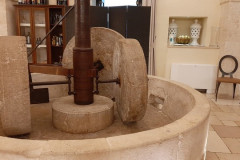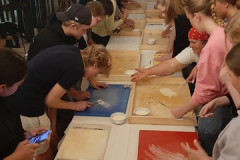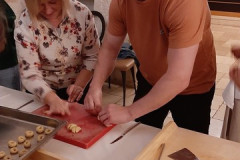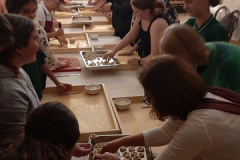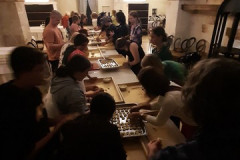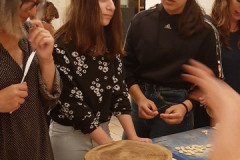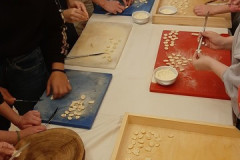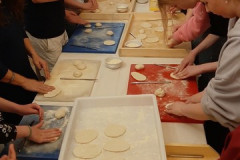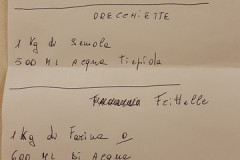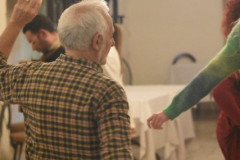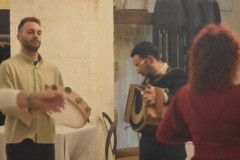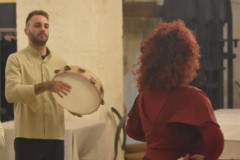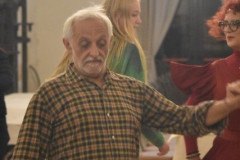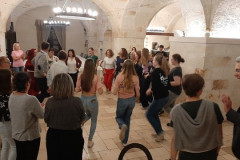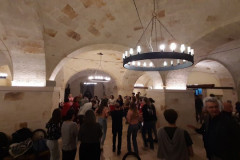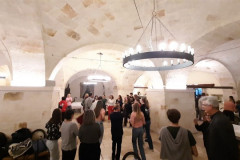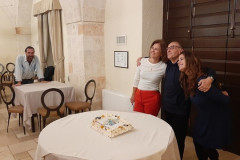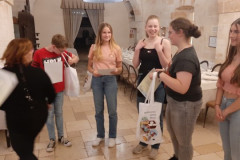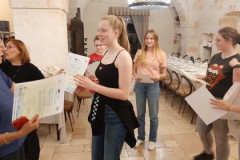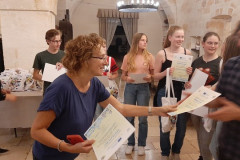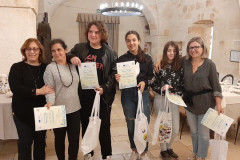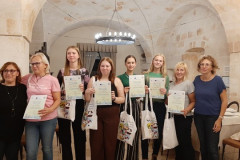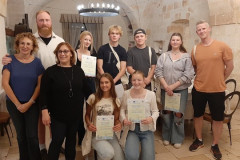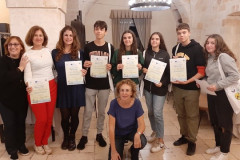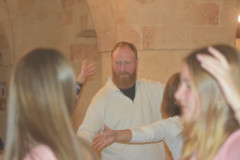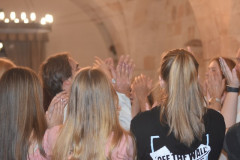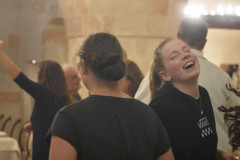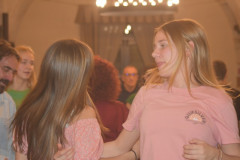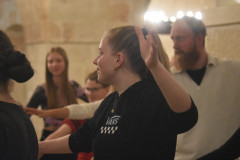Biodiversity meets music – Fifth meeting in Monopoli (Puglia, Italy)
Arrival – 06/11/22
Our journey started smoothly, as some parents provided a comfortable ride to Maastricht kiss & ride parking and welcomed us on the return to Heerlen – many thanks for that! At MAA airport, we passed the strict security checks. Afterwards, some piano players provided entertainment while waiting for the gate to open. Despite rumours that the flight was going to B(P)aris and that the Eiffel Tower would soon be in sight, we safely landed in Bari, the capital of Apulia.
From there, things got a bit strange, Vincenzo picked us up in his big Benz Vito, counted briefly, packed 8 people into 7 seats, and accelerated as if the ‘Ndrangheta was after him. In an accident on the motorway, which showed us the consequences of a crash, he skirted the traffic jam, knowing the place but constantly honking, and brought us to Monopoli to our accommodation in Via Ricasoli in record time. There we rang the bell and immediately a bag of rubbish came flying from above to greet us. Someone was probably too lazy to bring the household waste to the street themselves. After a phone call to Anita, she came over and showed us the flat. We divided the rooms and then went out to get something to eat in town. Nearby we found a pizzeria that prepared a wheel of pizza margherita and some greasy panzerotti from the remaining dough, which we devoured. Afterwards, we strolled through the old town and to the sea Mr Bock rated as suitable for swimming.
Day 1 – 07/11/22

As we were to learn, in Monopoli the rubbish collection is on its way early every day, so that some of us woke up quite early. As it was only a few steps to the school Istituto Comprensivo G. Modugno – G. Galilei, we had a leisurely breakfast with croissants, cappuccino, and cocoa at the Caffè La Nave opposite the school. Soon we spotted some familiar faces, as Magnus, who cannot be overlooked, turned up with his Norwegian students, who joined us.
Demonstrating the German virtues of punctuality and reliability we arrived at the school just in time, and we were welcomed by Francesca, Simonetta, the accompanying teachers from the partner schools and their pupils and were provided with everything important for the first activities.
We followed Francesca across the city to the Municipio, the city hall, where we sit down on the benches and chairs in the council hall to wait for Mayor A. Annese and Headmistress A. Demola. Both addressed some friendly words of welcome to us and pointed out the importance of such Erasmus exchanges to get to know each other and understanding different cultures and customs.
Afterwards, Francesca and Simonetta then divided and mixed the group, which were guided to the numerous sights in the old town of Monopoli. The Italian students (ragazzi or young guides) took the roles of tourist guides and reported interesting details. The guests paid particular attention, as on the next day the information provided would be very useful for a Monopoli game.
The lively port city of Monopoli, which lies between Bari and Brindisi and is overrun by tourists in summer, has a great past. In the Middle Ages, the town prospered from the trade in olive oil, wine, and almonds. Merchants became very rich, so that in 1530 the citizens were able to buy themselves free from the rule of Venice with 51,000 gold ducats and build numerous villas and estates in the surrounding countryside of Monopoli.
The city has always benefited from its safe harbour, already appreciated in ancient times by settlers from Hellas. The medieval harbour district with its winding alleys, the surprising views of the fishing boats (gozzi) and the opening perspectives of squares like Piazza Garibaldi with the modern Biblioteca Communale and the Torre Civica e Colonna Infame is very exciting and varied. At every corner you come across interesting buildings – churches, monasteries, and palaces. Directly at the harbour is the Castello Carlo V with its mighty tower. On the harbour wall of the castle there is an interesting relief painting with a fishing boat in the background. It reminds us of the efforts of the fishermen of Monopoli, who saved almost the entire crew of a damaged Greek ferry some 20 years ago. At the southern end of the harbour district is the Madonna della Madia cathedral. The magnificent baroque building built in the middle of the 18th century is atypical for this area and is already reminiscent of the architecture of Salento. The high tower is the landmark of the old town and appears in different colours at different times of the day.
After this interesting tour, both groups met again at the Municipio. Right next door we got a packed lunch prepared by Caffè Napoli, but Francesca told us to hurry up as the school bus was already waiting. It was amazing to see how many teenagers could fit into this bright yellow school bus, which was built for much smaller pupils. Francesca and colleagues took the other teachers with them in the car and drove to Parco Lama Belvedere where we again worked in small groups to identify trees and shrubs. There, Antonio Garganese and other teachers told us interesting facts about the use of the plants settling in this area.
The park is maintained by a citizens’ initiative, supported by local companies, and has various functions. On the one hand, the lama serves as a leisure and recreational space with playing facilities for children, on the other hand, it represents a green lung for the city of Monopoli with its almost 50,000 inhabitants. Finally, the canal ensures the controlled drainage of water after heavy rainfall.
The subsequent break was well deserved by all, as it was getting warm in the sun, and most of us spent the break in a shady spot in the park. As a reward for successfully finding and identifying the plants, Francesca offered each of us a pen in the shape of a flower.
After having refreshments and a delicious dessert, we walked through the park back to the school. In the auditorium, which can be used by all the schools in the building, we met for a pizzica workshop.
The pizzica is a traditional Italian folk dance from Apulia and Salento and a special form of the tarantella. It goes back to a healing dance of the rural population at the end of the 14th century, performed after they were bitten by tarantulas that could be found in the fields there. The name is derived from the Italian word pizzicare (to sting, to bite). We tried to keep the rhythm with the tambourines provided. The tale is that local musicians rushed to the bitten person’s house and played accelerating melodies on their instruments (violins, mandolins, guitars, flutes, harmonicas, and tambourines), singing along in the dialect. The person being bitten, who usually had a high fever by this time, began to dance. The aim was to drive the poison out of the body with the force of sweaty movements. Usually, family members and villagers joined in the dance, and finally the bitten person collapsed on the floor, exhausted, and hopefully cured.
Although the workshop leader and the dance group of Italian schoolgirls tried very hard to convert us into expressive pizzica dancers, many of us were already very exhausted. Before the impending collapse we preferred to take a break as a last healing step, because the day’s work was not yet done.
Now we had to show our homework for the first time. We had the task of rehearsing some songs that were to be presented to the parents on Wednesday at a performance together with the school choir and the orchestra. And that had to be practised, after all.
In addition to the Ode to Joy by Beathoven, which is known throughout Europe, these songs included Ma il cielo è sempre più blu (The sky is always bluer) by Rino Gaetano, which we were also able to sing along in Italian after the rehearsal, and an Italian children’s song that would prove to be a stubborn earworm over the next few days: Ci vuole un fiore by Endrico Sergio. During the rehearsal, we Germans managed to get our flag down, which was placed behind – who did that?
In the evening, all the groups met at the pizzeria Ai Portici – some of the teachers learned to enjoy the locally brewed beer, limoncello and the ice cold bitter liqueur Amaro del Capo. Later, most of the students quickly disappeared to their flats. Mr. Bock and Dr. O. still enjoyed rock songs from their youth and a cold drink at the Kambusa Rock Bar by the sea, where Mr. Bock became friendly with the dog Sheila.
Day 2 – 08/11/22

At 9.00 a.m. we started outside the school. While the pupils squeezed into the yellow minibus as on the previous day, the teachers were taken comfortably in the car to the starting point of the upcoming hike at Santo Stefano Castle, a beautifully situated little bathing bay about 4 km south of Monopoli. It was a pity that no one had brought swimming suits.
We spent the whole morning in splendid sunshine and very pleasant temperatures collecting and identifying typical plants of the coastal region, while we walked from bay to bay, from lama to lama back to Monopoli. On the way we found several fossilised seashells, and those who looked up could observe several swarms of birds dancing in the air, and hawks in shaking flight catching prey. Whether these were Eleonora’s falcons could not be found out.
The wealthy merchants of Monopoli invested their income from the export of almonds, wine, and olive oil in buying large estates in the countryside around Monopoli. In the last decades of the 19th century, extensive landscaped parks and gardens were created around the masserias, blending different styles.
Arriving in Monopoli, we had lunch at the Bakery Bistrot Granum and enjoyed a small but delicious buffet. After a rest, we gathered at the school in the afternoon, where half of the group dealt with the identification of the collected plants and created herbaria, while the others took part in a Kahoot quiz about Monopoli, which turned out to be not as difficult as assumed, as some of the most important facts were repeated beforehand. Then, the groups changed their tasks. Unfortunately, we didn’t really notice who won. While the students were busy with the activities, the coordinators met in the computer room for a hybrid meeting to exchange ideas to be implemented at the last two meetings in Trondheim and Stolberg next year.
Afterwards, some of the groups presented the results of their project work. Nora, Lorena, and Marcel presented an insight into the work of the beehive group and the mobile phone collection project at Ritzefeld-Gymnasium Stolberg, while Zoe reported on the project to produce apple juice from meadow orchards. In the process, the partners were able to try some home-made dried apple rings and the teachers were able to taste this year´s ´Ritze´ honey. The pupils from Seville also presented their projects before the group retired for a short time to freshen up for the joint dinner.
In the evening, we met again for dinner at the Caffè Napoli where the students had their dinner outside. Inside, the teachers sampled a veritable firework of traditional local and regional dishes at the trattoria tipica. With a total of 15 different dishes prepared for us, some quickly lost orientation, overview, and control over the maximum amount of food a normal mortal can eat. A final Amaro di Lugano didn’t help much. Nevertheless, a big hand to the kitchen and the waitress… meraviglioso! – as well as the final beer with Magnus, Stein and Jo in the nicely furnished pub The King.
Day 3 – Wednesday, 09/11/22

This morning we left by coach at 9.00 am – well, due to some folks from the South a little later – for Alberobello, the queen of the trulli in the region of the pointed cap houses. The quarters of Rione Aia Piccola and Rione Monti stretch along both sides of the centrally located Largo Martellotta. The Rione Aia Piccola impresses with its steep alleys, where numerous souvenir shops and restaurants can be found. At the top is the Chiesa di Sant’ Antonio having a roof construction – who would be surprised – in the trulli style. Alberobello has gained UNESCO World Heritage status since 1996 and since then has experienced a tourist boom. We first climbed up a few stairs to a balcony, where we took a group photo. After a short visit to the church, we met our guide at the Piazza del Popolo, who first led us through the Rione Aia Piccola district and explained the construction and function of the trulli. We were able to visit one of these simple farmhouses. On a mostly square base area, field stones were first formed into thick basement walls in dry construction, on which the slabs of stone (the chiancarelle) stacked at an angle on top of each other were arranged in a cone shape. The roof usually ended in a pinnacola, a roof peak, which was used as an individual characteristic of the houses or was supposed to secure the assistance of supernatural powers. One of the numerous tales is that the citizens declared their houses as cairns, as they were built without mortar and thus, they could avoid the land tax to the king.
Later, we walked up Corso Vittorio Emanuele to the neoclassical Basilica dei Sancti Medici, built by an architect from Alberobello and dedicated to two doctors. Behind the Basilica is the only trullo with an upper floor, the Trullo Sorrano, one of the oldest existing trulli, which was used as a farm, shop or dwelling and even served as accommodation for an entire community of monks.
We were then allowed to explore the trulli hill of Rione Monti on our own and, depending on our mood, pass the time with an extensive lunch break or a stroll through the alleyways, which some of us used to get some souvenirs for the family.
In the afternoon, we drove home again, past the extensive olive groves and finally down the slopes of the mountain range towards Monopoli, with magnificent views of the coastal plain and the Adriatic Sea.
Back at school, the big performance was on the agenda. After some of the music classes (cellos, strings, woodwinds, brass, etc.) had demonstrated their musical skills to the eagerly listening parents in the audience, and after the orchestra had presented itself, the stage filled up even more. The choir, which was enlarged by the pupils and teachers of the partner schools in our Erasmus project, took the stage for the finale grande. Giovanni Lenoci conducted the orchestra and choir in the presentation of Inno Alla Gioia – better known as Ode to Joy or Freude schöner Götterfunken. Then the catchy song mentioned at the beginning (Ci vuole un fiore) was performed. Finally, the international choir and orchestra – under the direction of Allessandro Giangrande – delighted the audience with Ma il cielo è sempre più blu and got them clapping along. Afterwards, Francesca introduced the participating partner schools, while all participating music teachers and the teachers of the partner schools gathered in front of the stage for a group photo – music combines:
The evening was spent together visiting the nearby town of Polignano a Mare, to which we travelled by train. After an evening walk around the old town, known as the pearl of the southern Costa di Bari, which is situated up on the cliff, criss-crossed by numerous grotti. The narrow streets of the whitewashed old town lead past viewing platforms over the cliffs of Lama Monachile to the Adriatic Sea glittering in the moonlight. Polignano is the hometown of the musician Domenico Modugno, who did not win the Grand Prix de la Chanson with his world-famous hit Volare, but won a Grammy. Around 7 pm, after another group photo at the Arco Marchesale, we stopped at the Ristorante Al Buco Preferito Tranquillage, where most of us enjoyed a delicious pizza. After an ice cream to go and on the way back to Monopoli, the various groups searched for the shortest route from the station to their accommodation, with the students finding their way without Google for once.
Day 4 – 10/11/22

As the day before, we met at the school to set off by coach towards Martina Franca. Although the baroque town has European status and one of the most beautiful town centres in the region, today our destination was different: Passing Alberobello and the mountains around Bosco Selva with the predominant tree species Quercus troiana (Macedonian oak), which this morning were still hidden in clouds, the bus drove along increasingly narrow roads to a gate where a carabiniere was waiting for us, who opened the gate and escorted us to the Riserva Naturale Orientata Murge Orientali. We were very surprised, because we had not expected this.
The aim of our excursion was to visit the Carabinieri Biodiversity and Parks Protection Command, which is headed by a divisional or brigadier general and is responsible for the protection of biodiversity in the 130 state nature reserves and the national parks (130,000 ha), as well as for the enforcement of CITES registrations (Washington Convention on International Trade in Endangered Species of Wild Fauna and Flora) signed in 1973. The Carabinieri Biodiversity Regiment is divided into 28 units and organised in three National Biodiversity Centres. The magnificently managed reserves comprise complex ecosystems, true treasure troves that host a variety of animal and plant species in unique habitats and landscapes. The reserves have different conservation objectives: orientation, biogenetics, zoology, population, anthropology, and nature protection. The Equestrian Selection Centre facilities are in the Gorgofreddo section of the reserve, which covers about 735 ha. It mostly consists of woods with a high proportion of Macedonian oak (Quercus troiana), which in Italy is found only in the regions of Puglia and Basilicata, and is associated with Quercus pubescens and, in sunny areas, with Quercus ilex (maquis, garrigue). The rare Campanula versicolor occurs on some limestone walls. Endemic plants include Carduus micropterus ssp. perspinosus, Centaurea centaurium, C. deusta, Crepis apula, C. corimbosa, Crocus thomasii, Echinops siculus, Iris pseudopumila, Linaria purpurea, Ophrys celiensis, O. oxyrrhincos, O. tarentina, Ornithogalum adalgisae, Stipa austroitalica, Teucrium siculum and Thymus spinulosus. In addition, the reserve is rich in other orchid species – up to 30 species have been identified so far.
Because the area is protected in its original integrity, the nature reserve is home to various mammals such as the wolf, the wild boar, the fox, the hedgehog, the stone marten, and the hare. As well, the area is rich of bids, e.g., robins, orioles, goldfinches, and hoopoes, which find ideal nesting sites in the extensive dry-stone walls. Strictly protected by the Bern Convention and the EU Habitats Directive are Bombina variegata (yellow-bellied toad) and Testudo hermanni (Greek tortoise), which are endangered in environments heavily influenced by humans. More common is the four-striped snake (Elaphe quatuorlineata), which feeds on small mammals, young birds, and eggs. The rare leopard snake (Elaphe situla) is also found here and finds shelter in the numerous dry-stone walls. Protected species also include the butterfly Melanargia arge (Italian Marbled White), an endemic species in central and southern Italy. Murgese horses are bred and trained at the centre itself and are used by the mounted units for representative service. By the way, the centre is almost self-sufficient in sustainable energy.
Our visit included a visit to the MuMur (Museum of the Murgese Horse) and the stables of the Carabinieri Equestrian Centre. On site, the group was split up. Outside the Masseria, there was a short introduction to the activities of the Carabinieri Biodiversità, including the preservation of the Macedonian Oak, of which many old and young specimens could be seen around the estate. This was followed by a short and amusing introduction to the art of riding (without a horse), with reference to an elegant and healthy way of riding, although the exercises of the group members rather indicated the opposite. During the subsequent visit to the museum, we learned a lot about the history of horses in general and the breeding of the Murgese horses, which are named after the Murge or the rural landscape of Murgia and whose genetic heritage is to be preserved. In the courtyard, some students and teachers could also get hands-on.
After a short break in front of the office, we walked through the oak forest with our carabiniere, who told us about the work of documenting the population development of the wolf in the region (National Monitoring Plan for the Presence of the wolf). Wildlife cameras to record individuals were numerous in place. We were also able to visit a currently used wolf den – but we did not get to see the wolves themselves. We were also able to visit a charcoal kiln (carbonaia) in the forest, which was built by woodcutters who carried out forest work during the winter months and extracted firewood from it, some of which they processed into charcoal. On our way back we could admire the work of a stomemason, who presented some fossils he found while he worked the rocks.
Until lunch time, the sun came out and displaced the clouds, so that we could enjoy the break in the warming sun. After this interesting morning in the Riserva Naturale Orientata Murge Orientali, we got back on the bus that took us to Bari and dropped us off on the coastal road near the Basilica of San Nikola. After a little search, we finally found our guide, whom some of us still knew from our first meeting in Kissamos (Crete): Roberto, where is Roberto? Well, Roberto who retired in the meantime but, as before, was bursting with energy. Thus, he took over the regiment from Francesca with enthusiasm and gestures to give us interesting facts about Bari and its history. After lunch on a viewing platform on the harbour wall, we immediately went into business. To list the numerous sights here would go far beyond the scope of this article. However, the white Cathedral of San Sabino, dating from the 12th century, and the Basilica of San Nicola, one of the most powerful and most worthwhile places of worship in Bari, deserve special mention. The basilica was built between the late 11th century and the early 12th century and serves as the final resting place of the relics of St. Nicholas and, until today, is an important pilgrimage site for Roman Catholics and Orthodox Christians.
When we finally arrived at Castello Svevo di Bari – the city’s landmark – most of us settled down on the outer boundary wall of the castle. The medieval fortress dates to the 12th century and was built by the Norman King Roger II of Sicily. In the subsequent centuries, it was destroyed, rebuilt, extended, and used as a prison and barracks. Some of us raised the last energy reserves and visited the inside of the Castello, which was worthwhile as various art treasures could be seen. Others, however, needed a little rest or time for shopping along Corso Vittorio Emanuele II. Later we met again left to the Museo Teatro Margherita at the harbour to return to Monopoli by bus.
At the Masseria Chianchizza in Monopoli, we took part in an orecchiette workshop. Everyone worked hard to form taralli, orecchiette and frittelle from a few ingredients using simple recipes. Later, the results could be tasted at dinner which – like every evening – was rich, varied and very tasty.
In the late evening there was a big surprise: a music group (accordion and tambourine) came in with a dancer and animated us to dance – of course the pizzica was on stage. The spark immediately jumped over, and everyone jumped up and joined to dance through the whole room, taking up the steps and turns of the dancer and the sounds and rhythms of the musicians, ending up in passionate, almost ecstatic dancing. One was amazed how much kinetic energy could still be released in pupils and teachers. And Roberto! Well, what can you say? Chapeau!
Finally, however, this lively and exuberant evening came to an end. Francesca and Simonetta did not miss the opportunity to personally present the certificates to the individual groups and to be present for the group photos. The glory of this unforgettable week in Monopoli was a farewell cake decorated with the project logo – of course everyone had to try it! In addition, enjoying the last Amaro together with some of the music teachers from Monopoli is worth mentioning. The journey home to the respective accommodation was taken over by the numerous teachers from the school – what a great willingness to help!
We had an eventful, fantastic week in Monopoli. We took many new impressions home with us, gained or deepened friendships, and are already looking forward to seeing each other again in Trondheim or at the final meeting in Stolberg!
Many thanks to Francesca, Simonetta, and the many other helping hands who miraculously contributed to the realization of this unforgettable and wonderful week.
Departure – 11/11/22
At just before 8.00 am, our taxi driver picked us up in front of our accommodation and, as expected, took us quickly to Brindisi airport. There we passed the security check and waited for the gate to open – some of us stopped by at the duty-free shops, others hung around with their thoughts or used their smartphones – there was not much time for that during the week, but nobody really missed it. The return flight went smoothly, and in Eindhoven we quickly found the bus stop for the shuttle to the train station. The buses were crowded, so we couldn’t all ride in the same bus. Fortunately, the shuttles left every few minutes, so we met again at the station for a snack and hot drink. A short time later we were on the train to Heerlen, which was also used by some Dutch ´Jecken´ and ´Narren´ to start into the carnival on 11/11 at some meeting in Limburg. When the students arrived in Heerlen, their parents’ taxis were already waiting to take them home, so we said goodbye, while Mr Bock and Dr O. hopped on the overland bus to Aachen wishing that they could immediately leave again for somewhere else … Monopoli? The dream goes on.
Finally, an eventful European week came to an end for us too. On Saturday, some of us were caught up in the daily routine of school at the Open Day at the ´Ritze´…
R. Ostrowski
Project Coordinator Stolberg
Presentations and Links
- Report on Instituto Comprensivo Modgno Galilei Website (Monopoli Group)
- Video Progetto Erasmus project “Biodiversity meets music” (Monopoli Group)
